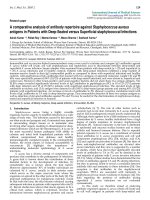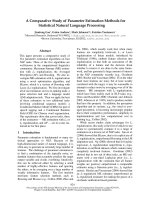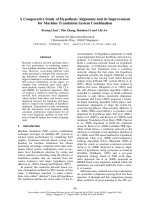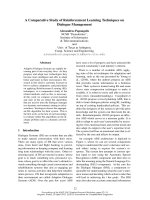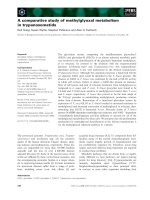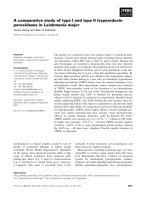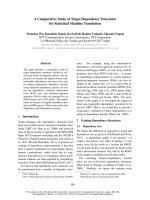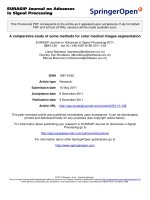Báo cáo y học: "A comparative study of anxiety and depression in patients with bronchial asthma, chronic obstructive pulmonary disease and tuberculosis in a general hospital of chest diseases" ppsx
Bạn đang xem bản rút gọn của tài liệu. Xem và tải ngay bản đầy đủ của tài liệu tại đây (172.14 KB, 4 trang )
BioMed Central
Page 1 of 4
(page number not for citation purposes)
Annals of General Psychiatry
Open Access
Primary research
A comparative study of anxiety and depression in patients with
bronchial asthma, chronic obstructive pulmonary disease and
tuberculosis in a general hospital of chest diseases
Georgios Moussas*
1
, Athanasios Tselebis
2
, Athanasios Karkanias
2
,
Dimitra Stamouli
2
, Ioannis Ilias
3
, Dionisios Bratis
2
and Kalliopi Vassila-
Demi
2
Address:
1
Attikon General Hospital, Second Psychiatric Department, Medical School, University of Athens, Greece,
2
Sotiria General Hospital of
Chest Diseases, Psychiatric Department, Athens, Greece and
3
Elena Venizelou Hospital, Athens, Greece
Email: Georgios Moussas* - ; Athanasios Tselebis - ; Athanasios Karkanias - ;
Dimitra Stamouli - ; Ioannis Ilias - ; Dionisios Bratis - ; Kalliopi Vassila-
Demi -
* Corresponding author
Abstract
Background: Depression necessitating assistance from health professionals has a lifetime
prevalence of 10%. Chronic disease increases comorbidity with mood and/or anxiety disorders.
Patients with chronic pulmonary disease present with severely impaired functionality, chronic
somatic and psychogenic pain, require frequent hospitalizations and have a dependency upon
medical and nursing personnel. In the present study we assessed anxiety and depression in patients
hospitalized for pulmonary disease in a pulmonary disease hospital.
Methods: We assessed anxiety, using the Spielberger state-trait anxiety scale, and depression,
using the Beck Depression Inventory, in 132 patients with pulmonary disease.
Results: A total of 49.2% of the sample had moderate or severe depression and 26.5% had anxiety.
Women had higher depression and anxiety scores than men (t test, p < 0.05). Depression was
positively correlated with anxiety, age and time from diagnosis. Anxiety was positively correlated
with depression and time from diagnosis (Pearson r = 0.62 and 0.29, p < 0.01). Patients with chronic
obstructive pulmonary disease and bronchial asthma had higher depression scores than patients
with tuberculosis (t test, p < 0.01).
Conclusion: Depression and anxiety are very prevalent in patients with pulmonary disease,
especially chronic disease. This may be a very important negative factor in patients' adaptation to
the chronic course of their disease.
Background
Among psychiatric diseases, depression, necessitating
assistance from health professionals, has a lifetime preva-
lence of 10% [1]. Furthermore, in the general population,
depression has a point prevalence of 2.3% to 4.9%. Up to
80% of patients with depression are either treated by non-
Published: 21 May 2008
Annals of General Psychiatry 2008, 7:7 doi:10.1186/1744-859X-7-7
Received: 16 March 2007
Accepted: 21 May 2008
This article is available from: />© 2008 Moussas et al; licensee BioMed Central Ltd.
This is an Open Access article distributed under the terms of the Creative Commons Attribution License ( />),
which permits unrestricted use, distribution, and reproduction in any medium, provided the original work is properly cited.
Annals of General Psychiatry 2008, 7:7 />Page 2 of 4
(page number not for citation purposes)
mental health professionals or receive no treatment at all
[2]. Chronic disease increases comorbidity with mood
and/or anxiety disorders. Usually, the more serious the
somatic disease is, the more probable it will be accompa-
nied by mood and/or anxiety symptoms of variable sever-
ity. Failure to manage such mental health problems
increases the patients' probability of suffering from com-
plications, even lethal. The lifetime prevalence of mood
disorder in patients with chronic disease is 8.9% to
12.9%, with a 6-month prevalence of 5.8% to 9.4%. [3,4].
According to findings from worldwide research, 20% of
patients with somatic disease suffer from major depres-
sion [4]. In relevant studies in Greece, 28.1% of patients
hospitalized in general medical or surgical hospital wards
had depression [5,6].
In patients with pulmonary disease in particular, func-
tionality may be severely impaired due to chronic psycho-
genic and somatic pain, frequent hospital admissions and
dependency from medical and nursing personnel. The
observed higher prevalence of depression and anxiety in
patients with chronic pulmonary disease – compared to
other chronic diseases – may be explained within this con-
text. Despite the fact that clinical experience accepts high
comorbidity in pulmonary patients, studies assessing and
comparing anxiety and depression levels among patients
with different pulmonary diseases are lacking in the Greek
literature. In the present study we assessed anxiety and
depressive symptoms in patients hospitalized in pulmo-
nary clinics with bronchial asthma (BA), chronic obstruc-
tive pulmonary disease (COPD) or tuberculosis (TB).
Methods
Depression was assessed with the Beck Depression Inven-
tory (BDI), which is widely used, and has been standard-
ized and used in the Greek population previously [7-9].
The BDI, one of the most popular depression rating scales,
includes 21 items graded from 0 to 3. The inner coherence
reliability is high and the re-test reliability ranges from
0.48 to 0.86 for clinical groups and 0.60 to 0.90 for non-
clinical population. Its validity in relation to an external
criterion for depression, such as clinical diagnosis, is con-
sidered to be satisfactory [7]. Anxiety was assessed with
the Spielberger state-trait anxiety scale, one of the well-
known and broadly used anxiety rating scales. The scale
consists of 40 items, each one graded from 1 to 4. The
scale differentiates anxiety to (a) anxiety caused by a spe-
cific condition (state subscale), and (b) anxiety as a more
permanent characteristic of the personality (trait sub-
scale). This second (trait) subscale was used in our study
protocol. The scale is considered as having a high inner
coherence reliability and validity compared to clinical
diagnosis [10-12].
Sample
The sample included 140 hospitalized patients, of which
8 subjects refused to participate and were therefore
excluded. The study included 132 patients (78 men and
54 women) in the pulmonary departments of our hospi-
tal. Of them, 42 were diagnosed with BA, 60 with COPD
and 30 with TB. They were considered for enrollment over
a 2-month period. All the participants were informed and
gave their formal consent.
The subjects replied to the questionnaires in the presence
of psychologists and/or psychiatrists familiarized with
such tests. We assessed age, gender, years of education,
duration of illness and diagnosis for hospitalization. Stu-
dent's t test was used to assess differences in anxiety or
depression between genders and among BA, COPD or TB
patients. Pearson's correlation was used to assess the
impact of anxiety on depression (and vice versa) as well as
the impact of age or time from diagnosis on anxiety or
depression. Logistic regression was used to assess the pres-
ence of depression (i.e. BDI scores > 13) as a function of
gender, age, time from diagnosis and anxiety. Descriptive
statistics are given as mean ± standard deviation (SD).
Results
The mean age of the sample was 54.08 ± 16.60 years and
mean time from diagnosis was 8.78 ± 9.14 years. Men
were older (57.44 ± 15.16 years) than women (49.22 ±
17.50 years, two-tailed t test, p < 0.05). There was no dif-
ference in the duration from diagnosis (two-tailed t test, p
= 0.56). Women had higher anxiety and depression scores
than men (two-tailed t test, p < 0.05); 49.2% of the sam-
ple had moderate to severe depression, and 44.0% of men
had depression symptoms compared to 55.6% of women,
whilst 21.8% of men had anxiety symptoms compared to
33.3% of women (Table 1).
Depressive symptomatology was positively correlated
with anxiety (Pearson r = 0.62, p < 0.01), age (Pearson r =
0.20, p < 0.05) and time from diagnosis (Pearson r = 0.39,
p < 0.01). The correlation of depression and age persisted
when time from diagnosis was used as a control variable
(partial correlation two-tailed p < 0.05). Anxiety was pos-
itively correlated with duration of illness (Pearson r =
0.29, p < 0.01). When depression was used as a control
variable, the correlation of anxiety with time from diagno-
sis was not maintained (partial correlation r = 0.12, p >
0.05). Patients with COPD had the higher depression
scores, followed by patients with BA, whereas patients
with TB had the lowest depression scores. Anxiety was
higher in patients with COPD compared to patients with
TB. Patients with COPD were older and had more years of
illness compared to those with BA and TB (t test p < 0.05).
BA patients were ill for a longer time compared to TB
patients (t test p < 0.05) (Table 2).
Annals of General Psychiatry 2008, 7:7 />Page 3 of 4
(page number not for citation purposes)
We also examined depression in relation to anxiety, years
of illness, gender and age by logistic regression. Logistic
regression showed that anxiety seems to be the major
determinant for depression (p < 0.001) (Table 3).
Discussion
The present study confirms that COPD patients are the
group with the higher and more severe depression comor-
bidity. Depression in patients with chronic respiratory dis-
eases coexists with anxiety and is related to the chronicity
of the disease in our study, which has a negative effect on
quality of life [13].
In recent years there has been a growing interest in the
relationship between chronic pain and depression [14].
Chronic respiratory diseases such as COPD and BA entail
serious subjective difficulties, chronic psychogenic and
somatic pain, frequent hospital admissions, hospital
dependency and dependency on oxygen. This metaphori-
cally and literally suffocating disease status may explain
the high percentage of depression in patients with COPD
and BA in the study, which was higher than the percentage
reported in studies performed with in-patients of general
hospitals [5]. Furthermore, this difference is verified by
studies performed with patients with respiratory failure,
with depression being observed in 30% of patients with
moderate failure and in 50% in patients with severe
obstructive pulmonary disease [15,16].
Anxiety and depression are very prevalent even in patients
with moderate COPD (categorized as such by respiratory
symptoms evaluation and functional tests using medical
criteria) [17]. Chronic disease and comorbidity with anx-
iety and depression apparently leads to increased use of
health services, approximately twice as often than in
patients with no psychological burden [18]. Psychosocial
stressors, such as death of a spouse or divorce, are closely
related to relapses and aggravations of respiratory disease,
especially in men, pointing to a link between psychologi-
cal factors and chronic pulmonary disease [19]. Patients
with COPD cannot cope adequately with everyday needs.
This inadequacy may lead to heightened anxiety and
depression, which in turn may worsen the everyday inad-
equacy. It has been reported that this is (probably) a factor
that leads BA and COPD patients to frequent hospital
admissions and even intensive care unit hospitalizations
[20].
It is accepted that current psychiatric practice has valid
ways to diagnose depression, implementing different
diagnostic criteria and taxonomic systems such as the
Diagnostic and Statistic Manual IV (DSM-IV) and Interna-
tional Classification of Disorders (ICD-10). The patho-
genesis of depression is becoming better understood and
therapy has a very high success rate. This progress sets the
necessity for a more successful detection of all forms of
depression, especially in chronic somatic patients and in
the elderly; a group in which depression often escapes
diagnosis, although in the elderly COPD is an important
cause of morbidity, disability and mortality [21]. As men-
tioned previously, COPD and BA are chronic diseases
with severe subjective difficulties, dependency on medical
Table 1: Patients studied by gender
Gender Age Time from diagnosis (Years) Anxiety Depression
Men (n = 78) Mean 57.45 9.18 42.44 12.71
SD 16.16 10.22 9.87 8.09
Women (n = 54) Mean 49.22 8.30 46.20 15.50
SD 17.05 7.76 10.13 8.14
Total (n = 132) Mean 54.08 8.78 43.98 13.85
SD 16.60 9.14 10.11 8.20
Table 2: Patients studied by disease
Gender Age Time from diagnosis (Years) Anxiety Depression
Bronchial asthma (n = 42) Mean 43.33 9.24 43.67 14.31
SD 14.28 6.90 9.96 7.45
COPD (n = 60) Mean 66.03 13.46 45.87 15.48
SD 9.61 10.57 10.36 8.42
Tuberculosis (n = 30) Mean 45.23 2.69 40.67 9.93
SD 14.99 6.51 9.19 7.71
Total (n = 132) Mean 54.08 8.78 43.98 13.85
SD 16.60 9.15 10.11 8.20
COPD, chronic obstructive pulmonary disease.
Publish with BioMed Central and every
scientist can read your work free of charge
"BioMed Central will be the most significant development for
disseminating the results of biomedical research in our lifetime."
Sir Paul Nurse, Cancer Research UK
Your research papers will be:
available free of charge to the entire biomedical community
peer reviewed and published immediately upon acceptance
cited in PubMed and archived on PubMed Central
yours — you keep the copyright
Submit your manuscript here:
/>BioMedcentral
Annals of General Psychiatry 2008, 7:7 />Page 4 of 4
(page number not for citation purposes)
and nursing personnel and dependency on oxygen. In
these diseases depression ranges from 30% in moderate
up to 50% in severe forms of COPD [15], a fact also veri-
fied in our study. Depression may be a very important
negative factor to treatment adherence for patients with
somatic disease. Additionally, it may hinder adaptation to
chronic disease conditions and it is known that adapta-
tion is a crucial survival factor in chronic diseases [22].
Conclusion
Patients suffering from BA and COPD have a significantly
higher rate of anxiety and depression compared to the
general population. A probable cause is the chronicity and
severity of pulmonary disease. Detection and manage-
ment of these mental disorders may ameliorate prognosis
of the pulmonary disease and improve adaptation and
quality of life of these patients.
Competing interests
The authors declare that they have no competing interests.
References
1. Wells KB, Golding J, Burnan MA: Psychiatric disorder in a sample
of the general population with and without chronic medical
conditions. Am J Psychiatry 1998, 145:976-979.
2. Regier DA, Goldberg ID, Tance CH: The de facto U.S. mental
health systems. Arch Gen Psychiatry 1978, 35:685-693.
3. Cassen EH: Depression and anxiety secondary to medical ill-
ness. Psychiatr Clin North Am 1990, 13:597-612.
4. Cassem NH, Bernstein JG: Depressed patients. In Massachusetts
General Hospital Handbook of General Hospital Psychiatry 5th edition.
Edited by: Stern TA, Fricchione GL, Cassen WH, Jellinek MS, Rosen-
banm JF. Philadelphia, PA: Mosby/Elsevier; 2004:25-68.
5. Lykouras E, Ioannidis H, Voulgaris A: Depression in general hos-
pital patients: preliminary results. Arch Hell Med 1987,
4:287-289.
6. Giannitsi S, Liakos A: Preliminary observations after implemen-
tation of two years of liaison psychiatry service in a general
hospital. Encephalos 1985, 22:138.
7. Beck AT, Steer RA: Manual for the Revised Beck Depression Inventory
San Antonio, TX: Psychological Corporation; 1987.
8. Donias S, Demertzis I: Validation of the Beck depression inven-
tory. In Proceedings of the 10th Hellenic Congress of Neurology and Psy-
chiatry: 1983 Edited by: Varfis G. Thessaloniki, Greece: University
Studio Press; 1983:486-492.
9. Tselebis A, Moulou A, Ilias I: Burnout versus depression and
sense of coherence: A study in Greek nursing staff. Nursing
Health Sci 2001, 3:69-71.
10. Spielberger GD, Gorush RL, Lusshene RE: The State-Trait Anxiety Inven-
tory Palo Alto, CA: Consulting Psychologists Press; 1970.
11. Liakos A, Giannitsi S: The validity of the Greek modification of
the Spielberger anxiety scale. Encephalos 1984, 21:71-76.
12. Tselebis A, Papaleftheris E, Balis E, Theotoka I, Ilias I: Smoking
related to anxiety and depression in Greek medical staff. Psy-
cholog Rep 2003, 92:529-532.
13. Anderson KL: The effect of chronic obstructive pulmonary dis-
ease on quality of life.
Res Nurs Health 1995, 18:547-556.
14. Campell LC, Claw DJ, Keefe FJ: Persistent pain and depression:
a biopsychosocial pespective. Biol Psychiatry 2003, 54:399-409.
15. Kunik ME, Roundy K, Veazey C, Souchek J, Richardson P, Wray NP,
Stanley MA: Surprisingly high prevalence of anxiety and
depression in chronic breathing disorders. Chest 2005,
127:1205-1211.
16. Light RW, Merrill EJ, Despars JA, Gordon GH, Mutalipassi LR: Prev-
alence of depression and anxiety in patients with COPD.
Relationship to fuctional capacity. Chest 1985, 87:35-38.
17. Di Marco F, Verga M, Reggente M, Maria Casanova F, Santus P, Blasi
F, Allegra L, Centanni S: Anxiety and depression in COPD
patients: the roles of gender and disease severity. Respir Med
2006, 100:1767-1774.
18. Gudmundsson G, Gislason T, Janson C, Lindberg E, Suppli Ulrik C,
Brondum E, Nieminen MM, Aine T, Hallin R, Bakke P: Depression,
anxiety and health status after hospitalization for COPD: a
multicentre study in the Nordic countries. Respir Med 2006,
100:87-93.
19. Cicutto LC, Brooks D: Self-care approaches to managing
chronic obstructive pulmonary disease: A provincial survey.
Respir Med 2006, 100:1540-1546.
20. Miller KE: Do anxiety and depression impact patients with
COPD? Am Family Physic 2003, 67:1327.
21. Yohannes AM, Baldwin RC, Connolly MJ: Depression and anxiety
in elderly patients with chronic obstructive pulmonary dis-
ease. Age Ageing 2006, 35:457-459.
22. Vanderpool M: Resilience: a missing link in our understanding
of survival. Harv Rev Psychiatr 2002, 10:302-306.
Table 3: Pearson correlation scores
Depression Anxiety Age Time from diagnosis (Years)
Depression Pearson correlation coefficient (n = 132) 1.00 0.62 0.20 0.39
Two-tailed p value - < 0.01 < 0.05 < 0.01
Anxiety Pearson correlation coefficient (n = 132) 0.62 1.00 0.13 0.29
Two-tailed p value < 0.01 - 0.14 < 0.01
Age Pearson correlation coefficient (n = 132) 0.20 0.13 1.00 0.34
Two-tailed p value < 0.05 0.14 - < 0.01
Time from diagnosis Pearson correlation coefficient (n = 107) 0.39 0.29 0.34 1.00
Two-tailed p value < 0.01 < 0.01 < 0.01 -
